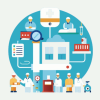
Patient Feedback Forms for Hospitals: Elevating Patient Care
Patient feedback forms are crucial in today’s healthcare environment, serving as a vital tool for enhancing the quality of care in hospitals. These forms allow hospitals to gather valuable insights directly from patients about their experiences.
Enabling healthcare providers to identify areas for improvement and celebrate successes. The simplicity and effectiveness of patient feedback forms make them an indispensable part of hospital management.
Importance of Patient Feedback Forms in Hospitals
Patient feedback forms are more than just a formality; they are a key element in maintaining and improving the standards of healthcare services. Hospitals rely on these forms to gauge patient satisfaction and identify areas that need attention.
By directly collecting opinions from patients, hospitals can take a proactive approach to enhancing the patient experience. Patient feedback forms serve as a mirror, reflecting the quality of service provided.
They allow healthcare providers to understand patient needs better, address concerns, and ultimately foster a more patient-centered approach. With this information, hospitals can implement changes that lead to improved care quality, increased patient satisfaction, and better overall outcomes.
Key Elements of Effective Patient Feedback Forms
Creating an effective patient feedback form requires attention to detail and a deep understanding of patient needs. A well-designed form should be straightforward, easy to understand, and quick to complete.
Here are some key elements that make a feedback form effective:
- Clear and Concise Questions: The questions should be easy to comprehend, avoiding medical jargon that might confuse patients. Simplicity ensures that patients can provide accurate feedback without feeling overwhelmed.
- Focus on Relevant Aspects: The form should cover all critical areas of the patient experience, including the quality of care, interaction with healthcare staff, cleanliness of the facility, and overall satisfaction.
- Multiple Response Options: Providing a range of response options, such as Likert scales or open-ended questions, allows patients to express their opinions more accurately.
- Anonymity: Patients are more likely to provide honest feedback if they know their responses are anonymous. Ensuring confidentiality can lead to more genuine insights.
- Follow-Up Questions: Including a section for additional comments can help hospitals gain deeper insights into specific issues that may not be covered by standard questions.
Role of Patient Feedback Forms in Improving Hospital Services
Hospitals can use patient feedback forms as a strategic tool to drive continuous improvement. By analyzing the data collected, healthcare providers can pinpoint weaknesses in their services and develop targeted strategies to address them. Here’s how patient feedback forms contribute to the enhancement of hospital services:
- Identifying Service Gaps: Feedback forms can highlight areas where patient expectations are not being met, allowing hospitals to address these gaps promptly.
- Enhancing Patient Communication: Feedback often reveals how well staff communicate with patients. Poor communication is a common source of dissatisfaction, and addressing it can significantly improve the patient experience.
- Improving Patient Safety: Patients may report safety concerns through feedback forms, enabling hospitals to address potential hazards and improve overall safety protocols.
- Boosting Staff Performance: Positive feedback can motivate healthcare staff, while constructive criticism can guide training and development efforts.
Designing Patient Feedback Forms for Different Hospital Departments
Different hospital departments may require customized patient feedback forms to address specific aspects of patient care. For example, the questions in a form for a surgical ward might differ from those in a maternity ward. Customization ensures that the feedback is relevant and actionable.
Surgical Department Feedback Forms
In a surgical department, feedback forms should focus on preoperative and postoperative care, communication regarding procedures, pain management, and the overall outcome of the surgery. These forms might include questions like:
- How well were the surgery procedures explained to you?
- Were your pain management needs adequately addressed?
- How satisfied were you with the follow-up care?
Maternity Ward Feedback Forms
For the maternity ward, patient feedback forms should focus on the quality of prenatal and postnatal care, support during labor, and the comfort and cleanliness of the ward. Questions might include:
- How well did the staff support you during labor?
- Were your postnatal care needs met?
- How satisfied were you with the breastfeeding support provided?
Challenges in Collecting and Analyzing Patient Feedback
Despite the importance of patient feedback forms, hospitals often face challenges in collecting and analyzing this data. Understanding these challenges is crucial for maximizing the effectiveness of feedback forms.
- Low Response Rates: Patients may be reluctant to fill out feedback forms, leading to low response rates. This can result in a limited view of patient satisfaction, making it harder to draw accurate conclusions.
- Bias in Responses: Patients who had either very positive or very negative experiences are more likely to complete feedback forms, which can skew the data.
- Data Overload: Hospitals can receive a large volume of feedback, making it challenging to analyze and act on the data efficiently. Prioritizing key insights is essential to ensure actionable results.
- Technical Issues: If feedback forms are distributed digitally, technical problems such as a lack of internet access or difficulties using the platform can hinder participation.
Overcoming Challenges in Patient Feedback Collection
To overcome these challenges, hospitals can adopt several strategies to improve the effectiveness of their patient feedback forms.
- Encourage Participation: Hospitals can increase response rates by actively encouraging patients to complete feedback forms. This can be done through reminders, incentives, or by integrating the form into the discharge process.
- Ensure Accessibility: Providing feedback forms in multiple formats, such as paper, online, or through mobile apps, ensures that all patients can participate, regardless of their technological comfort level.
- Simplify the Process: Making the forms as short and simple as possible can encourage more patients to complete them. Focus on the most critical questions to avoid overwhelming patients.
- Use Data Analytics: Advanced data analytics tools can help hospitals manage large volumes of feedback, allowing them to quickly identify trends and areas for improvement.
The Future of Patient Feedback Forms in Hospitals
The evolution of patient feedback forms is set to continue as hospitals adopt more innovative approaches to collecting and analyzing patient feedback. The integration of technology, such as artificial intelligence and machine learning, into feedback processes, holds great promise for the future of healthcare.
Digital Transformation
Digital feedback forms are becoming increasingly popular due to their ease of use and efficiency. Hospitals can now deploy feedback forms via emails, SMS, or patient portals, making it more convenient for patients to provide feedback.
Additionally, digital forms can be designed to be more interactive, guiding patients through the process and ensuring all relevant areas are covered.
Real-Time Feedback
Real-time feedback systems allow hospitals to collect patient opinions immediately after a service is provided. This immediate data can help hospitals address issues as they arise, rather than waiting until the end of a patient’s stay.
Real-time feedback can also be more accurate, as patients are more likely to remember details about their experience shortly after it occurs.
AI-Powered Feedback Analysis
Artificial intelligence is transforming how hospitals analyze patient feedback. AI can quickly process large amounts of data, identifying patterns and trends that might not be immediately apparent to human analysts. This allows hospitals to act on feedback more rapidly and effectively.
Personalized Feedback Requests
Personalizing feedback forms based on the patient’s treatment journey can lead to more relevant and actionable feedback. For example, a patient who underwent surgery would receive a different set of questions than a patient visiting for a routine check-up.
Personalization ensures that the feedback collected is specific to the patient’s experience, providing more valuable insights.
Implementing a Patient Feedback Form Strategy in Hospitals
Developing a comprehensive patient feedback form strategy is essential for hospitals aiming to improve patient care. This strategy should involve all stakeholders, from administrative staff to healthcare providers, ensuring a coordinated effort to collect and act on feedback.
Steps to Implement a Patient Feedback Form Strategy
- Set Clear Objectives: Define what the hospital hopes to achieve through patient feedback. Whether it’s improving patient satisfaction, enhancing safety protocols, or boosting staff performance, clear goals will guide the entire process.
- Involve Stakeholders: Engage all relevant parties in the design and implementation of feedback forms. This includes not only healthcare providers but also administrative staff who will manage the data.
- Choose the Right Tools: Select appropriate platforms for distributing and analyzing feedback forms. Consider digital tools that can automate the process and provide advanced analytics.
- Pilot the Program: Before rolling out feedback forms hospital-wide, conduct a pilot program in one department to test the effectiveness of the forms and make any necessary adjustments.
- Analyze and Act on Data: Regularly review the feedback collected, and develop action plans to address the issues identified. Ensure that the findings are communicated to all relevant departments.
- Monitor and Adjust: Continuously monitor the feedback process, making adjustments as needed to improve response rates and data quality.
Best Practices for Using Patient Feedback Forms
Hospitals can maximize the benefits of patient feedback forms by adhering to best practices in their design and implementation. These practices ensure that the feedback process is efficient, effective, and aligned with the hospital’s goals.
Keep it Simple
The feedback form should be simple and focused. Avoid overloading patients with too many questions, and stick to the most important aspects of their experience. Simplicity increases the likelihood that patients will complete the form.
Train Staff on Feedback Collection
Staff should be trained on the importance of patient feedback and how to encourage patients to participate. This training can help staff communicate the value of the forms to patients, increasing response rates.
Regularly Update Forms
Patient needs and hospital services evolve, so it’s essential to regularly update feedback forms to reflect current practices and concerns. This ensures that the feedback collected is always relevant.
Promote Transparency
Hospitals should be transparent about how patient feedback is used. Sharing the results of feedback and the actions taken in response can encourage more patients to participate in the future.
Patient Feedback Forms: Impact on Patient-Centered Care
Patient-centered care is at the heart of modern healthcare, and patient feedback forms play a critical role in achieving this goal. By prioritizing patient opinions and using them to inform care decisions, hospitals can create an environment where patients feel valued and understood.
Patient feedback forms help hospitals build trust with their patients. When patients see that their opinions matter and lead to real change, they are more likely to engage with the hospital and share their experiences. This trust is essential for creating a positive healthcare experience.
Additionally, patient feedback forms contribute to a culture of continuous improvement. Hospitals that actively seek and act on feedback are better equipped to meet the needs of their patients, leading to higher satisfaction and better health outcomes.
Long-Term Benefits of Patient Feedback Forms
The long-term benefits of implementing patient feedback forms in hospitals are substantial. These forms provide a consistent source of data that can be used to track trends over time, identify persistent issues, and measure the effectiveness of interventions.
Over time, patient feedback forms can help hospitals build a reputation for excellence. By consistently responding to patient needs and improving services, hospitals can position themselves as leaders in patient care. This reputation can attract more patients, enhance community trust, and contribute to the hospital’s overall success.
Conclusion
Patient feedback forms are an indispensable tool for hospitals committed to improving the quality of care and patient satisfaction. By carefully designing, implementing, and acting on feedback forms, hospitals can create a patient-centered environment that fosters trust, enhances service delivery, and ensures continuous improvement.
The insights gained from these forms are invaluable, helping hospitals to identify areas for improvement, celebrate successes, and ultimately provide better care for their patients.
Frequently Asked Questions?
What are patient feedback forms?
Patient feedback forms are tools used by hospitals to gather insights from patients about their healthcare experiences. They help identify areas for improvement and enhance patient satisfaction.
Why are patient feedback forms important in hospitals?
Patient feedback forms are crucial for understanding patient needs, improving service quality, and fostering a patient-centered care environment. They provide valuable data that hospitals can use to make informed decisions.
How can hospitals encourage patients to fill out feedback forms?
Hospitals can encourage participation by integrating forms into the discharge process, offering multiple formats (paper, digital), and explaining the importance of feedback to patients.
What challenges do hospitals face in collecting patient feedback?
Common challenges include low response rates, biased responses, data overload, and technical issues with digital forms. Addressing these challenges requires strategic planning and the right tools.
Enhance Patient Care and NABH Compliance with LazyMonkey
LazyMonkey is your all-in-one solution for improving patient care, retaining more patients, and meeting NABH standards. Our powerful QR-based feedback tool enables you to capture real-time insights from patient feedback, discharge surveys, staff and doctor evaluations, and clinical research, while also streamlining inter-departmental communication.
Transform your healthcare facility today - reach out to us at hello@lazymonkey.in, or request a demo here!
Elevate Your Restaurant Experience with LazyMonkey
LazyMonkey’s QR-based feedback system helps you gather real-time insights from customers, track satisfaction levels, and enhance the dining experience. Get instant feedback on your menu, service, and ambience, and make data-driven improvements to boost repeat customers and reviews.
Improve your restaurant today – reach out to us at hello@lazymonkey.in, or request a demo here!
Empower Student Engagement and Campus Improvement with LazyMonkey
LazyMonkey offers a seamless way to gather student feedback, track satisfaction, and enhance campus life. From course evaluations to dorm feedback, our QR-based solution makes it easy to capture valuable insights and improve student retention.
Upgrade your university experience – contact us at hello@lazymonkey.in, or request a demo here!
Streamline Feedback and Drive Performance Across Your Enterprise/Franchise with LazyMonkey
Whether you manage one or multiple locations, LazyMonkey’s QR-based feedback system helps you gather real-time employee and customer feedback. Improve operational efficiency, track satisfaction, and make data-driven decisions to enhance brand consistency and growth.
Transform your franchise today – reach out to us at hello@lazymonkey.in, or request a demo here!
Enhance Customer Satisfaction and Service Standards in Banking with LazyMonkey
LazyMonkey empowers banks to capture real-time feedback from clients across branches. Improve customer experience, assess service quality, and ensure regulatory compliance with our QR-based solution, helping you retain clients and meet banking standards.
Elevate your bank’s customer care – contact us at hello@lazymonkey.in, or request a demo here!
Boost Customer Engagement and Mall Satisfaction with LazyMonkey
LazyMonkey’s QR-based feedback tool enables you to collect feedback from shoppers, track satisfaction, and enhance the mall experience. Gather insights on store services, cleanliness, and entertainment to create an unmatched customer journey.













